|
Summary:
Every 120 years or so a dark spot glides across
the Sun. Small, inky-black, almost perfectly circular,
it's no ordinary sunspot. Not everyone can see it,
but some who do get the strangest feeling, of standing,
toes curled in the damp sand, on the beach of a
South Pacific isle.... Get the full
story from Science@NASA.
Page
1 | Page
2 | Page
3 | Page
4 | Page
5 | Page
6 | This is Page 7
| Page 8
| Page 9
| Page 10
| Page 11
| Page 12
| Page 13
| Page 14
| Page 15
Unless otherwise stated, all images are copyrighted
by the photographers.
|
| |
Photographer,
Location |
Images |
Comments |
|
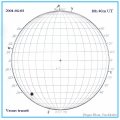
|
Jörgen
Blom,
Stockholm, Sweden
Jun. 08, 2004 |
#1 |
When
looking at the sun's projection in my 'sun-box', I
was amazed by the largness of Venus. Venus surely
would be considered a giant sunspot if it fact had
been one. But according to my calculations the inky
and perfectly round spot that was Venus would not
have been bigger than about 400 millionths of the
sun's hemisphere if it were a spot on the center of
the sun's disk. A spot of that size is barely visible
whith the naked eye. But Venus was an easy naked-eye
object. Why? Probably because the planet was much
blacker and also much bigger than any sunspot umbra.
|
|

|
Shevill
Mathers,
Campbell Town, Tasmania, Australia, site of the US Naval
Observatory Expedition to observe the 1874 Transit of
Venus.
Jun. 08 |
#1,
#2, #3,
#4, more |
Takahashi
Mewlon 210 Dall-Kirkham, Thousand Oaks glass solar
filter. Afocal with a William Optics 24 mm eyepiece
and a Nikon Coolpix 995 digital camera. Light scudding
cloud and haze at many levels. |
|
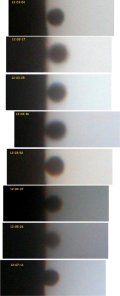
|
Eric
Walker,
Culloden Moor (Inverness), Scotland
Jun. 08 |
#1,
#2, #3,
more |
After
getting up at 4:30am and setting up at Culloden Moor
by 5:30am the Highlands Astronomical Society members
had to wait until just after 11:00am to record our
first sightings. We even had to endure a very heavy
period of rain about 10:30am. Typical Scotland, but
it was worth it though! The images are back-to-front
as they were viewed through a 114mm reflector with
a 32mm Plossl + 2x Barlow. Images were taken (afocal)
using a Nikon Coolpix 5700 and cleaned up with Adobe
Photoshop. |
|
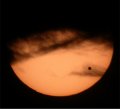
|
Rémi
Boucher,
Mont-Megantic, Quebec, CANADA
Jun. 08 |
#1,
#2, #3,
#4 |
Here
in Quebec, we only got the end of the transit, but
it was pretty spectacular to see the sun rising with
Venus' silhouette in front of it. |
|
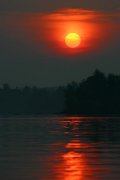
|
Brad
Templeton,
Over Stony Lake, near Peterborough, Ontario
Jun. 08 |
#1,
#2, #3,
#4, more |
Wildlife
and haze surround the transit of venus at sunrise
over the Kawarthas. The clouds and Venus make the
sun look like Jupiter. |
|

|
Chris
Cook,
Cape Cod National Seashore, Massachusetts
Jun. 08 |
#1,
more |
Details:
Takahashi FS102 @ f/8 Fujicolor Superia 200 film.
|
|
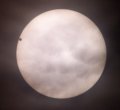
|
Terry
Pundiak,
Palmer Township, PA
Jun. 08 |
#1,
#2, #3 |
These
were taken with a Kodak DX 4600 (4 meg) camera hand
held into the Pentax eyepieces on an 8 inch old Coulter
Dob. Real viewing was so neat! So obviously 3 dimensional
- Venus stuck out so far in front of the Sun - amazing
effect considering the use of just one eye! |
|

|
Geoff
Chester,
Washington, DC
Jun. 08 |
#1,
#2, more |
Images
were captured with a 20-cm Schmidt-Cassegrain telescope
with a f/6.3 focal reducer and a Philips ToUcam Pro
740K webcam between 11:05 and 11:10 UT. Each frame
is a composite of 100 raw images captured at 5 frames
per second for 20 seconds, composited and processed
with Registax 2.1. |
|

|
Daniel
O'Malley,
Okemos, MI
Jun. 08 |
#1 |
From
6:10 until 6:55 I used a Nikon CP 4500 and a pair
of cellophane eclipse sunglasses in front of the CP
lens to catch the Venus transit. A very low-tech photo.
|
more:
from
Marcelo Kaczmarech of Ponta Grossa, Parana, Brazil;
from Dave Gulyas
at the Lorain International Marina, Lorain, Ohio,
USA; from Frank Lach
of New York, New York, USA; from
Kevin Walsh of Fanwood, NJ, USA (projected from
a 6' Newtonian telescope); from
Linda Smith at the Thomas G. Cupillari Observatory
in Fleetville, PA, USA; from
Joe Webster of Annapolis, MD, USA; from
Patrick Chevalley of Geneva, Switzerland; from
Anthony Liu of Hong Kong; from
Tiganus
Marian
of Braila, Romania (projected from 20x50 binoculars
to a case of a computer);
|
back to spaceweather.com
|
|